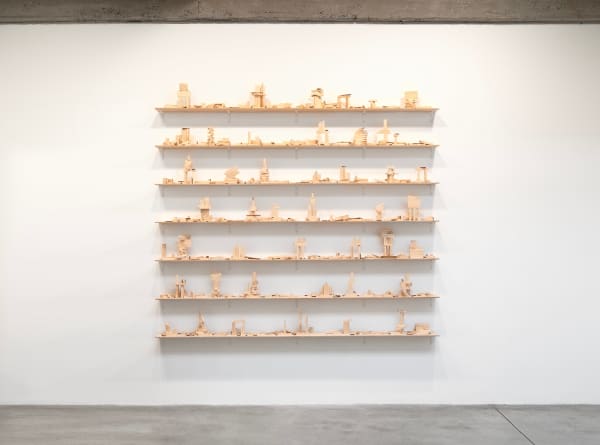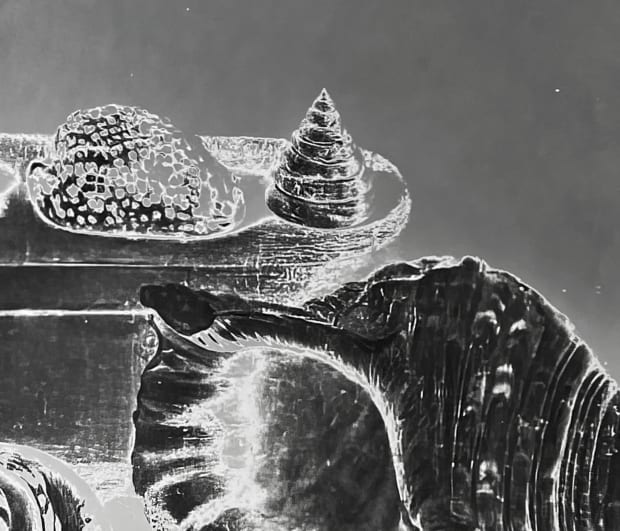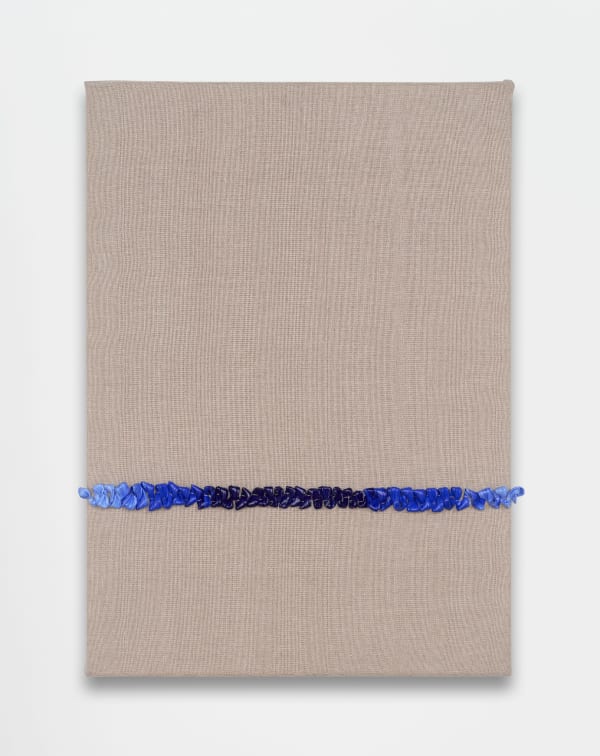-

-

-
MATH BASS

-

-

-
-

-

-

-

-

-

-

-

-

-

-

-


Material tactility, its possibilities, limitations, and transformation form the core of Kelly Akashi's practice. Originally trained in analog photography, traditional processes and the materiality of documents continue to inform and fuel her sculptural explorations. Working in a variety of media, such as wax, bronze, fire, glass, silicone, copper, and rope, Akashi investigates the capacity and boundaries of these elements and their ability to construct and challenge conventional concepts of form.


Building on her investigation of visual perception, Barth's series Deep Blue Day explores notions of the atmospheric and ephemeral through light as it shifts over time. Here, Barth overtly manipulates her surroundings by drawing the folds of her living room curtains in order to shape shifting rays of sunlight over the course of an afternoon. While photography is always about light and exposure, this work is a beautiful example of Barth's new engagement with light, where she uses it in an almost sculptural or performative way.


Over the past decade, artist Math Bass has developed a lexicon of symbols—letters, bodily forms, architectural fragments, animals, bones— arranged in a variety of scores, each symbol an empty space of meaning, filled in by the context in which it finds itself. Repetition of these symbols, rather than codifying them into one solid signification, exposes the difference at the heart of each iteration; there is always a gap in meaning, something unnamable left out of and left over in the viewer’s reading—a jouissance. It is this gap in the symbolic where Lee Edelman states queerness lies —not as an easily categorized liberal identity but as a process of unmaking and undoing that leaves (gendered) subjectivity as we know it in question. That these symbols are familiar only heightens our unsettling; the negative space of these compositions, a major player in Bass’s practice, adds further to the gap.


Sassy, Queen. It’s all too common to hear these terms used to describe women—and only women. In this diptych from 2023, Monica Bonvicini wields stencils and pink spray paint to inscribe the two words onto a mirror surface, silkscreened with a chain pattern. The adjectives demand to be seen and heard, shining a light on the ingrained sexism within everyday language while confronting the attached implications of 'Sassy' and 'Queen,' often linked to strong women and shackled by stereotypes concerning sexuality and power.
In “Sassy Queen”, Bonvicini builds upon and extends the visual language introduced for example in her 2020 series, NEVER TIRE, carrying a sense of urgency reminiscent of protest forms within the political realm. Engaging in a direct dialogue with drawings such as “Hot Like Hell”, “ME ME”, and “Fem Me”, she delves further into the portrayal of female identity and sexuality in popular culture through the medium of language. However, in this work, the unique projection of the original silkscreen print onto a mirrored surface not only enables viewers to see themselves reflected in these adjectives but also empowers them to reclaim and unapologetically embody a new persona.
The recurring chain pattern, a distinctive element in Bonvicini's visual repertoire, serves as a backdrop, making once again a profound statement about the role of art and architecture in the creation of desires and fantasies. Overall, “Sassy Queen” is a work that stands as a powerful declaration, calling for a narrative shift—a homage and endorsement of female strength echoing Nico’s voice: “I'll be your mirror. Reflect what you are, in case you don't know”.


Since the early 1990s, Sandra Cinto has developed a rich vocabulary of symbols and lines to create lyrical landscapes and narratives that hover between fantasy and reality. Using drawing as her point of departure, the artist renders intricate and mesmerizing seascapes, rainstorms, and celestial skies that frequently engage with the surrounding architecture to create seemingly weightless, immersive environments. Evoking stories of human hardship and redemption, Cinto's fantastical imagery serves as a metaphor for the human odyssey, while also pushing the limits and possibilities of drawing.



In 2009, Olafur Eliasson began a series of circular paintings inspired by the idea of producing a new, comprehensive color theory that would cover all the visible colors of the spectrum. He first worked with a color chemist to mix in pigment an approximate tone for each nanometre of visible light, which ranges in frequency from approximately 390 to 700 nanometres. Since those initial experiments, Eliasson has branched out to make a large number of painted works on circular canvases, known collectively as 'the color experiments'. This particular painting takes the color wheel idea and adds a literal twist: the prismatic colors spiral clockwise in towards the empty circular core.
From up close, the viewer sees that the gradient is created by rhombic patches of single colors. Each patch is slightly lighter or darker than the last, progressing along the spectrum towards the next tone. The juxtaposition of closely related hues tricks the eye into believing the individual rhombi are not homogeneous patches of a single color but fade within the borders from dark to light. The effect conjures an illusion of a disc made from myriad three-dimensional scales.
This work was created in tandem with a second painting that spirals in the opposite direction. The two works were loosely inspired by the Coriolis effect, which determines the movements of weather patterns on Earth and causes the winds on the southern and northern hemispheres of our planet to spiral in opposite directions.


Five polyhedrons, constructed from glass and mirrors, are stacked one atop another in a column. The column feels slightly destabilizing or off-balance, as the glass solids overlap, with the vertices of one extending into the face of another, and the axes vary from one to the next.
The glass polyhedrons are contained within a stainless-steel framework that outlines, ghostlike, the same forms in a different order. These five forms, known since ancient times as the Platonic solids, are the only polyhedrons that can be produced using identical, regular polygons for faces – the tetrahedron, octahedron, icosahedron, dodecahedron, and cube. Over the millennia they have been accorded special significance in philosophy, religion, science, and art.
Half of each glass polyhedron is made from coloured panes, while the other half is formed from panels of mirror with their black backs facing outwards. The colours of the glass correspond to the primary tones of the subtractive colour model commonly used in print processes: cyan, magenta, and yellow. Where the panes overlap, the hues mix to form a surprising range of colours, compounded by their reflections in the inwardly facing mirrors. As viewers move about the space and take on new perspectives, the colours mix, and the work seems to constantly change and evolve.


In this work, Shilpa Gupta disassembles national flags into discrete symbols and blocks of shapes, several of which bear uncanny resemblance to one another. Like a set of wooden blocks that reminds of a Jenga game, the pieces are grouped together to create new configurations that blur or reimagine the original geopolitical relations.
While flags are closed systems that are codified (you are not allowed to be creative with them), Shilpa brings an element of open-ended-ness into this work, suggesting that they could be fluid and interchangeable.


Laura Lima’s new works have a deep connection to the history of Brazil and concretism, but also an interesting relationship with the light and space movement in California. The Leviane works in particular have an ethereal and atmospheric quality that evokes similar perceptual phenomenas through the use of dry ice. Referencing the history of landscape painting, Lima uses the smoke as a painting tool to blur the color and details of the pieces, creating shadows akin to how one creates painterly atmospheric qualities. In a domestic setting, the dry ice is optional and can be added whenever desired.


Cressida and Chaos is made using a modified version of the “lost wax” technique, a process of casting bronze that has been in use for over 5,000 years. The initial shape of the shield and figures were created extemporaneously in clay, then taken to a foundry where the procedural steps of building molds, waxes, ceramic shells and castings had to follow standard artisanal practice. Long found further inspiration in the colorful irradiant markings left on the bronze surfaces during the post casting finishing process. These transient "heat patinas” are as fugitive as rainbows, disappearing with the slightest touch after the work cools. Long photographed and made studies to replicate those iridescent colors, then transformed them in scale and pattern back onto the surface through mists of permanent transparent pigments.


Remarkable in execution and detail, Head with Thin Blue Vertical was created within an intimate logic that has now become signature to Manders' practice. The work appears to be soft clay mid-way through the process of becoming a sculpture. The artist freezes a very specific moment in time, highlighting the fragility of every moment that passes. The manipulation of material generates a sense of puzzlement and awe, masterfully creating a sense of timelessness— while the sculpture seems to be just made, it is at the same time enigmatically atemporal.
For more than two decades, Mark Manders has developed an endless self-portrait in the form of sculpture, still life, and architectural plans. Described by the artist as his ongoing “self- portrait as a building,” Manders’ works present mysterious and evocative tableaus that allow viewers to construct their own narrative. Juxtaposing carefully composed figurative elements alongside architectural fragments, Manders thrusts the world we know into sharp contrast and heightens our perceptual understanding. The artist gives physical form to a dreamlike psychological space where objects are often made strange by some detail, for instance subtle alterations in scale. Manders freezes this transitional moment in time forever, highlighting a sense of fragility and timelessness simultaneously.


Oppenheim’s starting point for this work is an archival image of a still life painting from the circle of Jacques LIndard (1597) that was in the collection of Jacques Goudstikker, the esteemed Jewish Dutch art dealer in Amsterdam who fled the Netherlands when the Nazis invaded. He left behind three furnished properties that included an extensive collection of over 1200 Old Masters paintings. The entire collection was surveyed by Herman Göring personally and was subsequently looted by the Nazis.
Despite the Goudstikker family’s efforts to regain possession of the collection after the war, most of it was never reclaimed. This painting was one of those whose fate remains unknown. Embracing its mysterious disappearance, Oppenheim transforms the painting into its reproduced elements. Utilizing her smoke technique, she uses a flame to expose and then solarize the negative in her darkroom. In Oppenheim’s work, fire becomes a generative force allowing not for a recreation of what was lost, but rather the creation of a new artwork based on what was left.


For more than three years, Sherrill Roland's right to self-determination was lost to a wrongful incarceration. After spending ten months in prison for a crime he was later exonerated for, he returned to his artistic practice, converting the haunting nuances of the surrounding aesthetics into sculptural works that explore intense longing under physical and psychological constraint, and the inner-strength required to sustain self-hood under insurmountable circumstances.
Shaped like domino tiles, the Boneyard diptychs resemble the Brutalist architecture of prisons. While incarcerated, Roland read a Bible passage (Ezekiel 37:1-14) recounting the story of the valley of dry bones, which are without life and spirit, and how they are brought back to life. Struck by the parallels to incarcerated individuals, piled high and anonymous in number, they are also experiencing a lack of hope and are in desperate need of a resurrecting force that makes them whole again.


Analia Saban dissects and reconfigures traditional notions of painting, often using the medium of paint as the subject itself. This body of work continues Saban's investigations into the relationship between paint, pigment and canvas. In this work, thin layers of dried acrylic paint is woven through the linen, physically embedded into the fabric of the painting.


Informed by the worlds of art, architecture, natural sciences, and engineering, Saraceno's work invites viewers to consider geometries and phenomena of the natural world as adaptable models for the ways we live and interact. The piece is comprised of a complex geometric structure of translucent iridescent plexiglas that suggests the cell-like membranes of bubbles that emerge when oil is shaken with water. As in an organic system, this work is composed of many parts all similar but all different from one another, whose interconnected elements capture the iconic and intricate complexity of Saraceno's oeuvre.

Founded in 2006, Slavs and Tatars mine the complexities and unexpected affinities across cultures through publications, lecture performances, and installations. The collective explores a literary and political geography known as Eurasia, defined by themselves as “east of the former Berlin Wall and west of the Great Wall of China”.
Dark Yelblow is a part of a series of unique glass blown lamps (the Slavic etymology of melon stems from the verb дыть or "to blow”), each a nod to a particular species of melons of Central Asia, in particular in Uzbekistan and Xinjiang. The melons represent repositories of knowledge, as vectors of writing, as well as agencies of resource extraction. Considered a rare delicacy, the winter melon is carefully stored in warehouses (ковунхане) to ripen late, amongst the last fruit to do so as the first frosts arrive. The melon is coveted throughout Eurasia as an exceptional, almost miraculous product of nature: a luscious, sugary yield within an otherwise increasingly barren season and landscape.



Throughout her practice, Wearing has employed various kinds of masks—from literal disguises to voice dubbing—either to conceal or emulate the physical identities of her subjects. Me as Sander is from Wearing’s series of self-portraits that feature the artist dressed as selected art historical figures who have been particularly influential to the artist's own practice. These works are all derived from iconic photographs of famous, deceased heroes, such as Robert Mapplethorpe, Diane Arbus, Andy Warhol, Claude Cahun, and as pictured below, August Sander. Me as Sander is based on August Sander’s self-portrait from 1925, which was part of his project entitled “People of the 20th Century”. This photo series is comprised of portraits of figures who were considered to be on the fringes of society. Including portraits of homeless people, artists and bohemians, Sanders also included a self-portrait in the series, thinking of himself as an outsider of his community. By dressing up as Sander and mimicking a famous self-portrait of the artist, Wearing challenges his project, showing how easily the boundaries of identity are blurred.
In 2012 and the following year, Wearing created self-portraits of three photography forefathers recognized for their documentary portraiture and their promotion of photography as an art form: August Sander, Weegee and William Henry Fox Talbot. Often shot outdoors, the seemingly casual frontal portraits of German photographer Sander (1876 - 1964) defined a cutting-edge reportage approach. Sander applied this objective style to his legendary uncompleted project to comprehensively represent the people of his time based on their roles in German society. Despite the social masks Sander's sitters present to the world, their keenly recorded features and direct gazes convey their individuality. For Me as Sander, Wearing hews closely to a 1925 self-portrait by the photographer, faithfully reiterating, with minimal intervention, his starkly rendered face and piercing eyes.


Interested in language and its inevitable abstraction, Lisa Williamson leans into the formal considerations of sculpture to create works that are visually precise, physically resonant, and often attune to the spaces in which they are exhibited. The artist’s idiosyncratic practice follows a logic that is associative; compressing internal experience into forms that are both tangible and resistant at once. While there is a significant level of reduction and abstraction throughout the artist’s work, aspects of architecture, landscape and the figure remain visible throughout.
